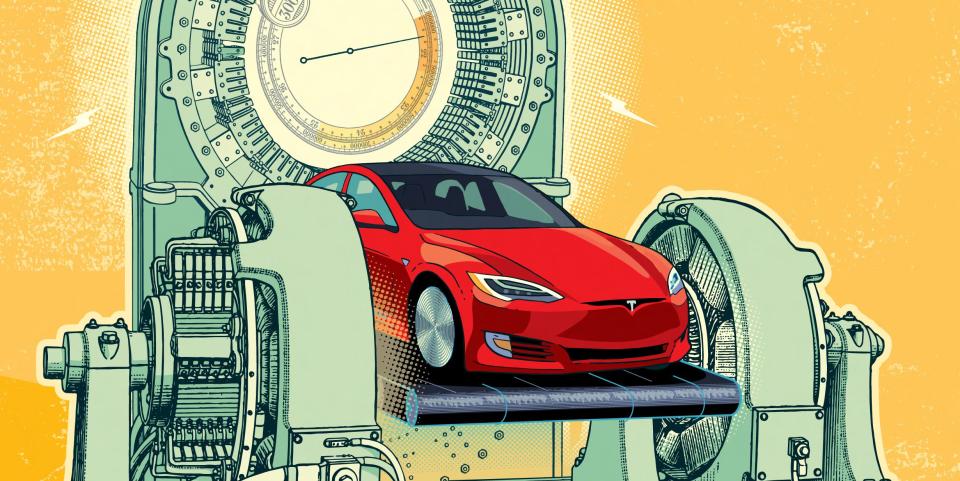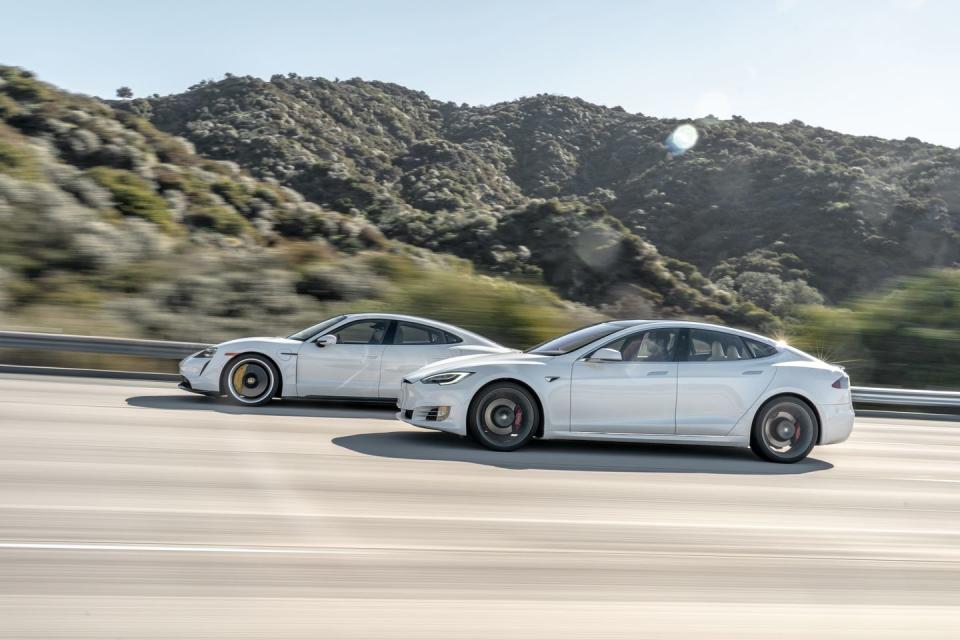The Secret Adjustment Factor Tesla Uses to Get Its Big EPA Range Numbers

From the September 2020 issue of Car and Driver.
A flurry of competitors is closing in on the Tesla Model S's 265-mile EPA range. Porsche's Taycan hits between 192 and 203 miles; the Audi e-tron, between 204 and 218 miles. The Jaguar I-Pace covers 234 miles. And the Chevy Bolt EV is nipping at the Model S's tread blocks with a 259-mile range.
There's just one problem. The Tesla Model S earned that EPA range estimate eight years ago. Today's Tesla with the longest reach, the Model S Long Range Plus, can cover a whopping 402 miles by the EPA's yardstick.
When it comes to EV range, Tesla appears untouchable. Despite pouring billions into electric-vehicle programs, established automakers have failed to make up much ground when it comes to the range game, and winning that game remains a crucial part of winning over buyers. So how does Tesla do it?
We were especially curious because our own 75-mph highway testing shows Teslas, on average, miss their label range by 27 percent, while all other EVs have missed the mark by 22 percent. Given that—and recent fuel-economy and emissions scandals at Ford, Hyundai-Kia, and Volkswagen—we couldn't just take Tesla at its word. Instead, we enlisted IHS Markit to help us work through the EPA's, SAE's, and automakers' documentation, plus we did our own vehicle testing to tease out how Tesla hits those big range numbers. The company's domination largely boils down to three factors. Let's take them one at a time.
The Adjustment Factor
Digging into the specifics of EV range quickly uncovers a rabbit hole of dense technical documents, such as the SAE's 32-page J1634 standard that governs range and efficiency testing. Here's the summary: EVs are strapped to a dynamometer—essentially a treadmill for cars—and repeatedly run through a test regimen that ends only when the battery is depleted to the point that the vehicle can no longer maintain the required speed. This procedure uses the same EPA city cycle (20-mph average speed over 7.5 miles with 18 stops) and highway cycle (48-mph average speed, 10.3 miles) used for fuel-economy tests of all light-duty vehicles. Both cycles feature extremely gentle driving; the most aggressive acceleration would be equivalent to an 18-second 60-mph time. Between city and highway loops, the test calls for a steady speed of 55 or 65 mph to deplete the battery. The EPA knows these low-speed tests aren't representative of the real world, so every EV's window-sticker range is the product of an adjustment factor that yields a more realistic consumer-facing figure.

This is where it gets interesting. The default adjustment factor reduces the window-sticker range by 30 percent. So a car that achieves 300 miles of range during the city-cycle dynamometer test ends up with a 210-mile city rating. However, the EPA allows automakers the option to run three additional drive cycles and use those results to earn a more favorable adjustment factor. Currently, only Tesla and Audi employ this strategy for their EVs, and Tesla scores the most advantageous results, with adjustments that range from 29.5 percent on the Model 3 Standard Range Plus to 24.4 percent on the Model Y Performance. If Tesla had used the standard adjustment factor of 30 percent, the Model Y Performance's window-sticker range would drop to 292 miles. But because Tesla takes advantage of the EPA's alternate methodology, the company can instead claim a 315-mile range.
This is all within the regulatory rules. Among EV makers, Tesla has been at this game longer than most, so it's not surprising that it has figured out the tricks to maximizing its EPA numbers. This dual-method testing dates back to the EPA's 2008 overhaul of fuel-economy labels. Initially, the agency wanted all vehicles to undergo five-cycle testing, but automakers claimed it was an overwhelming burden and the EPA relented. The agency then came up with a way to convert two-cycle results into five-cycle ones, and today, many automakers exploit this gamesmanship between the two methods for their gas-powered vehicles.
When it comes to EVs, though, the EPA came up with the default 30 percent adjustment factor back in 2011, when there were very few electrics on the market to analyze. The agency tells us it initially plucked the figure from the test results of the Toyota Prius, and after a subsequent analysis in 2015 showed that the Prius's factor was a solid guess, it chose not to change it.
When we asked the EPA how it expects range figures to correlate with real-world driving, it reinforced that one of the primary goals of fuel-economy labeling is to make it possible for people to compare vehicles powered by disparate fuels, which it believes this adjustment factor achieves. But for the still emerging EV market, we think it's important to have range figures that are both comparable with other EVs' and achievable in the real world. The alternative adjustment method clouds comparison, and we're not convinced that it creates results that are better aligned with real-world driving, particularly at realistic highway speeds such as 75 mph, which is the velocity we use to derive our highway efficiency and range figures [see "EVs Deserve a New Test"].
Big Batteries
This may be obvious, but a battery that holds more energy should translate to more range, and Tesla has the largest battery packs out there. In 2012, when the Model S came out, Tesla offered an 85.0-kWh pack as its largest option. Today, buyers can spec one that's 15 percent bigger than that, with 98.0 kilowatt-hours. And among lower-priced EVs, the Model 3 and Y lead the way with 75.0-kWh batteries.

What isn't always obvious is how much of a battery pack's energy is usable versus its maximum theoretical or gross capacity. To protect the battery from excessive degradation over time, EVs never fully drain or fully charge the pack. Some automakers disclose gross capacity, some report usable energy, and some provide both. But plenty are cagey on the details. For example, when the Taycan launched, Porsche claimed it had a 93.4-kWh battery capacity, which is closing in on the Model S's. That made the Taycan's low range figures even more surprising. But it turns out that the amount of usable energy in the Taycan's pack is only 83.7 kilowatt-hours, or nearly 15 percent less than that of the Model S.

 Yahoo Autos
Yahoo Autos 